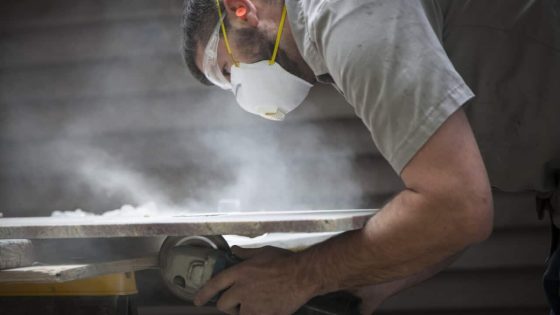Key Points
- Data shows that at least 579 Australians have silicosis and up to 600,000 workers are exposed to silica dust.
- Most people with silicosis do not show any symptoms in the early stages of the disease.
- Some states and territories will have transitional arrangements which will allow certain engineered stone work to continue until 31 December 2024.
From 1 July, Australia’s nationwide ban on engineered stone, commonly used for kitchen bench tops, will come into effect to protect workers’ health, making Australia the first country in the world to implement such a policy.
But former stone workers like Dan* say the ban has come “too late”.
The Sydney resident, in his 50s, worked in the industry for over a decade before he was diagnosed with silicosis — an incurable lung disease caused by inhaling silica dust, which can be fatal in severe cases.
“I’ve been coughing for five years now. It hasn’t stopped,” Dan told SBS Chinese.
“The upper lobes of my lungs are fibrotic and it’s getting worse, with fibrosis starting in the middle and lower lobes last year.”
Silicosis is commonly diagnosed after inhaling a dust mineral commonly found in certain types of stone used to create kitchen bench tops. Source: Getty / Bill Oxford
Danforn Lim, an adjunct professor at the University of Technology Sydney and Western Sydney University, that inhaling silica particles leads to the development of scar tissue (fibrosis) in the lungs, which impairs lung function and causes breathing difficulties.
“Fibrotic (damage) cannot be reversed because lung tissue cannot be regenerated. A patient’s condition only worsens with time,” Lim said.
“Common symptoms include shortness of breath, chest pain, cough, and tiredness.”
According to, at least 579 Australians are living with silicosis and up to 600,000 Australian workers are currently exposed to silica dust as part of their employment.
Medical expert Danforn Lim says silicosis is an “irreversible” lung disease with no cure. Source: Supplied
After his diagnosis in 2019, Dan was informed that he could no longer work in the industry.
But as a father of two, quitting was not an easy decision for him as his job was the family’s only source of income, he said.
He switched to installing engineered stone in customers’ homes, with much less exposure to silica dust, before leaving the industry altogether in 2022.
It’s not much money, but it’s better than nothing … I don’t know what to do.
Dan*
The only compensation Dan received was from the New South Wales (NSW) Dust Disease Care (DDC) scheme run by state insurance company Insurance and Care NSW (icare), providing more than $700 per fortnight for a year, which is less than one-fifth of his previous earnings.
Dan said the icare subsidy would end on 28 June but he planned to apply for it again as long as he was unemployed.
To make ends meet, he sold his work car and relied on his parents’ inheritance. His wife had taken on a part-time job caring for the elderly to support the family.
“I’d like to have a new job, but I can’t do physical work because of my health,” Dan said.
“[If I do non-physical work], it would also be awkward if I kept coughing while talking with clients.”
Help is available
The federal government suggested that injured employees should seek support from their state or territory workers’ compensation schemes. These schemes vary in their workers’ compensation arrangements and the supports available to eligible individuals across different jurisdictions.
Lily Shen, a case coordinator from DDC management, said icare offered financial compensation and career change assistance to eligible applicants who contracted silicosis due to their work in NSW.
“If you are diagnosed with dust disease, it is strongly recommended that you stop all work involving hazardous dust to avoid any additional exposure,” Shen said.
“DDC provides career services to help you identify and obtain suitable employment opportunities, which may be in a different role at your current workplace or elsewhere.”
With the assistance of icare, former stonemason James* now works in a wood-processing plant in Sydney after being diagnosed with silicosis during a routine health check-up.
He said icare subsidised the gap between his earnings from his two jobs, so he essentially received the same amount of money as he did when he was a stonemason.
However, inflation and interest rate rises have forced the father of two to cut back significantly.
The subsidy is certainly not as high as the wage increase I would have received if I had continued to work at the stone factory.
James*
“Not only do I need to take care of myself, but I also need to support my family,” he said.
In most cases, people with silicosis and it can take years to be diagnosed after initial exposure.
Former stone worker James* changed his career after being diagnosed with silicosis during a routine check up. Source: SBS
A former owner of a stone factory, Michael* said he did not realise that engineered stone products were damaging his health until after working in the stone industry for 20 years.
He said he was told his lungs were “partially non-functional” when he visited a doctor five years ago for shortness of breath when climbing stairs and lifting objects.
As the breadwinner, if I can’t work and have to live on social assistance, that’s not life.
Michael*
“I was taken aback,” he said.
The three former stone workers with silicosis then filed legal actions, and while James’s case has been closed, Dan and Michael’s cases are still ongoing.
Despite the ban on engineered stone coming into effect next Monday, Steve Zhang, a lawyer and partner of Littles Lawyers in Sydney, predicts an increase in silicosis-related legal cases in coming years.
Steve Zhang from Littles Lawyers in Sydney predicts an increase in silicosis-related legal cases in coming years.
“People who have been working in the stone industry for a long time have lung problems to a greater or lesser degree as they get older,” Zhang said.
“It may take 10 to 15 years for some people to develop symptoms [after first explosure].”
There could be an outbreak of cases related to silicosis in a few years.
Steve Zhang
predicts that approximately 10,000 Australians will develop lung cancer and up to 103,000 workers will be diagnosed with silicosis over their lifetimes as a result of their exposure to silica dust at work.
The Australian Department of Employment and Workplace Relations (DEWR) stated, “there is no need to remove engineered stone from homes or workplaces as it does not pose health risks if left undisturbed”.
Ban kicks in
A Department spokesperson told SBS Chinese that ministers responsible for work health and safety at both federal and state levels decided to ban the use of engineered stone in response to the rise of silicosis diagnoses in engineered stone workers.
“The ban will commence in all states and territories from 1 July 2024. Some states and territories will have transitional arrangements which will allow certain work to continue until 31 December 2024,” the spokesperson said.
Transitional arrangements apply to NSW, South Australia, Western Australia, Tasmania and the Northern Territory.
*not their real names.







